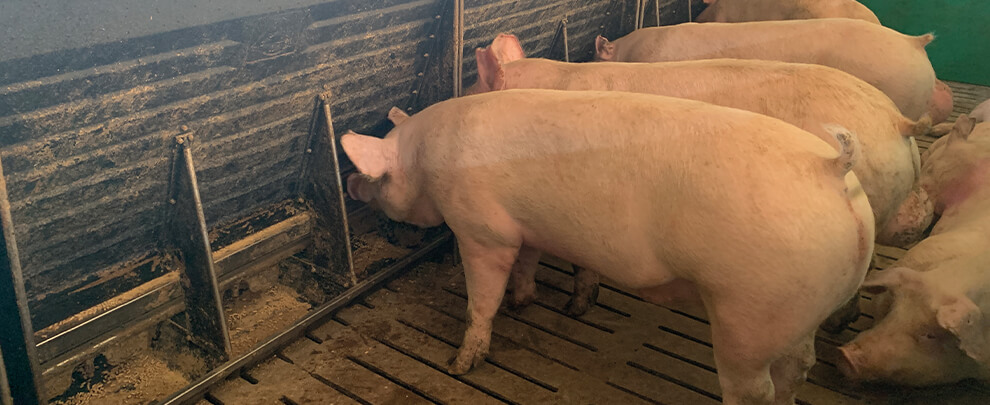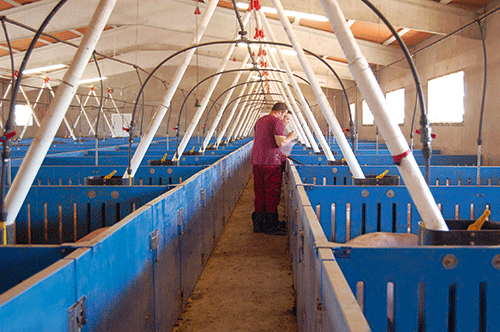Blog
Blog

Five ways to improve the feed conversion ratio
08th October 2025 - News
Óscar Toledano. Rotecna Sales Manager
The feed conversion ratio (FCR), the amount of feed required to produce one kilogram of live weight, is one of the most critical parameters influencing the profitability of pig farms, because feeding costs from weaning to fattening represent 50–60% of total production costs.
Although key factors such as genetics, animal health status, entry and exit weights, sex, castration status, and feed composition and presentation all play a role, many aspects directly controlled on the farm can have an equal or greater impact on this indicator.
Below are five significant opportunities farmers can leverage to improve efficiency.
Feeder management
The most profitable and straightforward action on any farm is proper feeder management. Correct adjustment and, for wet feeders, proper water flow are vital to ensure there is neither excess feed nor excess water in the pan, both are critical for achieving a reasonable feed conversion rate (FCR). The goal is to keep feed in the pan without it being overly clean and licked, which would indicate insufficient feed flow and reduce average daily gain. At the same time, we must avoid feed accumulation (if feed piles up at the sides, excessive flow will occur, resulting in waste). For dry feeders, the target pan coverage is 30–40% at weaning and 20–30% during fattening.
Hoppers should not be filled with more feed than animals consume in a day. Using telescopic downspouts is essential, especially on weaner feeders, to preserve feed quality and maximise intake while avoiding delays when switching diets. It is also imperative that hoppers never run empty unless fasting is required.
Barn climate
One of the most common mistakes is underestimating the impact of temperature, ventilation (gas renewal), and humidity on feed intake and growth.
Too low a temperature forces the animal to spend more energy keeping warm, which increases FCR; excessive heat reduces voluntary intake to limit metabolic heat production, slowing weight gain, a problem aggravated when relative humidity is high.
Barns should be adequately insulated and equipped with a well‑calibrated climate control system to keep temperatures as close as possible to the animal's comfort range by weight, using forced ventilation, heating, and/or cooling as needed.
Newly weaned piglets should not be exposed to temperatures below 26°C or above 32°C; 22–30°C for transition pigs; and 18–26°C for fattening. Relative humidity should not fall below 40% or exceed 75%. CO₂ levels should remain under 2,000–3,000 ppm, depending on the animal's age.
Stocking density
The ideal pen not only meets legal requirements but also supports natural behaviour and access to feed and water. Overcrowding leads to increased fighting, stress, unequal access, and poorer growth outcomes. We should maintain the correct stocking density by weight and reduce density during periods of heat stress if thermal comfort cannot be maintained or if tail‑biting outbreaks occur.
Recommended minimums are 0.20–0.35 m²/animal at weaning and 0.65–1.10 m²/animal during fattening.
Also consider the optimal number of animals per feeding space, which depends on feeder type, intake per animal, and eating speed. Eating speed rises with animal size and is higher with pelleted and wet feed, but lower under heat stress (intake concentrates during cooler hours, increasing competition).
Generally, allow 2–3 animals per feeding space for newly weaned piglets, 4–6 for those weighing up to 25 kg, and 8–15 for those weighing up to 120 kg.

We must maintain good biosecurity practices. Photo: Rotecna.
Water access and quality
Water is the most important, and paradoxically, the most neglected, nutrient. Poor quality or limited access can directly affect feed intake, as pigs require water to digest correctly.
If flow rates are low or drinkers are poorly placed, animals eat less or more slowly, which penalises FCR.
Actual water intake and waste vary widely by stage and depend on ambient temperature; water temperature and quality; age and feed intake; diet composition; feed presentation in the feeder (mash/pellet; dry/wet, more use of the drinker means greater apparent consumption); animal health; stocking density; competition for watering points; and the design, placement, adjustment, and efficiency of water‑delivery systems. A nipple drinker typically doubles consumption compared with a nipple‑in‑cup system, and a level drinker halves consumption compared with a cup.
Average drinker consumptions by phase:
- 2–4 L/day per transition piglet
- 4–8 L/day per fattening pig
The optimum number of animals per watering space depends on feeder type and feed presentation (fewer animals per drinker with dry mash; more with wet pelleted feed). As a rule of thumb, allow 8–14 piglets per drinker (0.5–0.7 L/min flow) and 10–15 animals in fattening per drinker (0.7–1.0 L/min).
Not using extra drinkers with wet/dry feeders reduces overall water consumption and can aid the start‑up of weaned piglets by offering feed and water at the same point. However, because animals must drink where they eat, there should be fewer animals per feeding point to avoid slowing growth. Where barn temperatures are high, supplementary drinkers are recommended and can be disconnected during colder periods. Likewise, having extra drinkers allows the wet/dry feeder drinkers to be closed to curb average daily feed intake and reduce fat deposition in the final growth stages of very heavy pigs (above 120–130 kg).
Of total apparent water consumption, only 5–10% is used for growth, metabolism, and thermoregulation. The remaining 90–95% ends up in pits as slurry (a mix of excrement and urine with water and feed residues).
Biosecurity measures
Pathogen pressure is one of the major enemies of efficiency. Even without obvious outbreaks, a farm with spreading pathogens will see poorer growth and higher feed use. Mild digestive or respiratory infections silently compromise digestion and daily gain.
The lower the environmental pathogen load, the healthier the animals, and the better the FCR without medication. Good internal and external biosecurity practices are therefore essential: access control and a secure perimeter fence; a single entry with a disinfection pit and mandatory shower and clothing change; restricted access for unauthorised vehicles and people; vector control (birds, rodents, insects, etc.); a pest‑control plan; hermetic closures on silos, stores, windows, etc.; and keeping the surface of barns free of vegetation and waste.
Where possible, implement all‑in/all‑out systems, avoid mixing animals of different origins and ages, and maintain separate loading and unloading areas. Apply strict downtime between batches, including deep cleaning and disinfection. Follow a logical sequence for staff movement, from highest to lowest health status, change or disinfect boots between zones, and use dedicated equipment in each area. Carcass and slurry management must also prevent staff and vehicles involved in these tasks from contacting "clean" areas.
Optimising these five areas can significantly improve FCR, delivering 5–25% gains that may translate into a 3–15% reduction in production costs. Careful attention to these details supports viability and sustainability, preparing farms for periods of volatile costs and tight margins.








